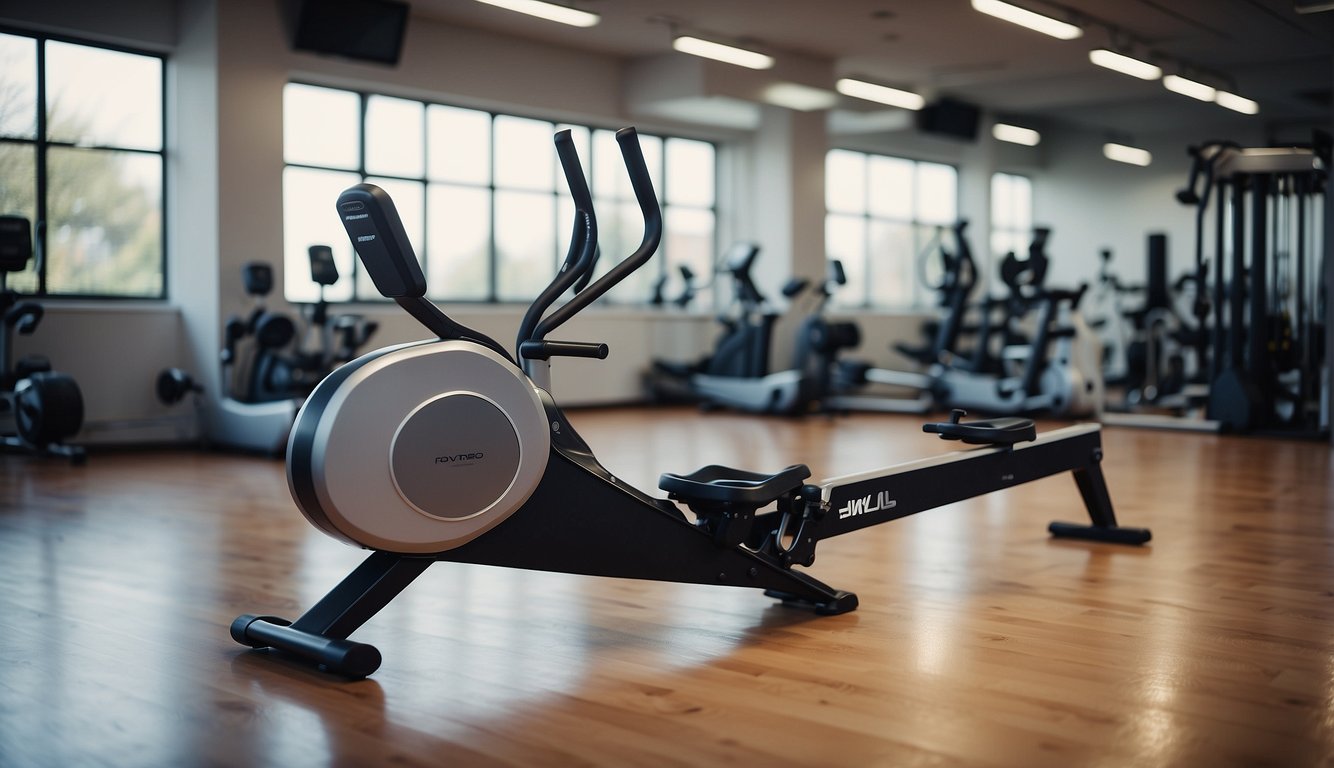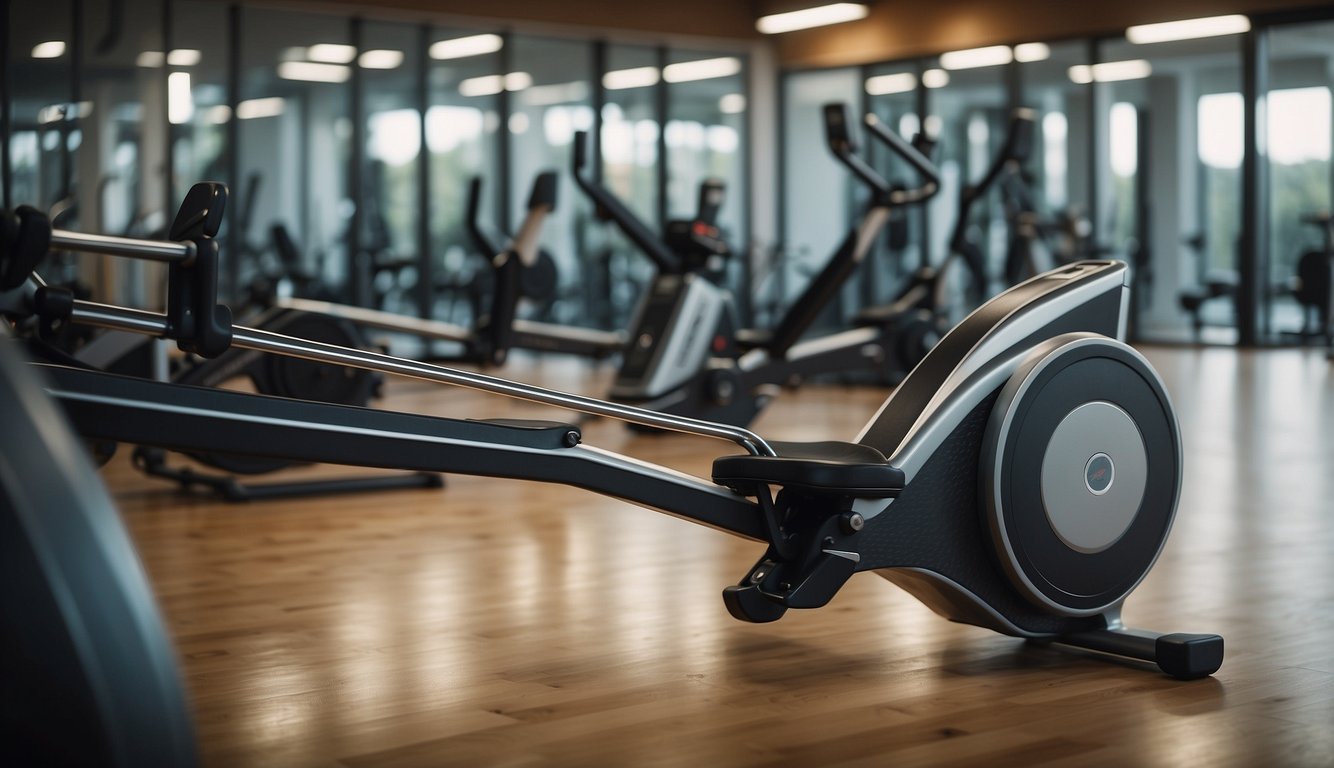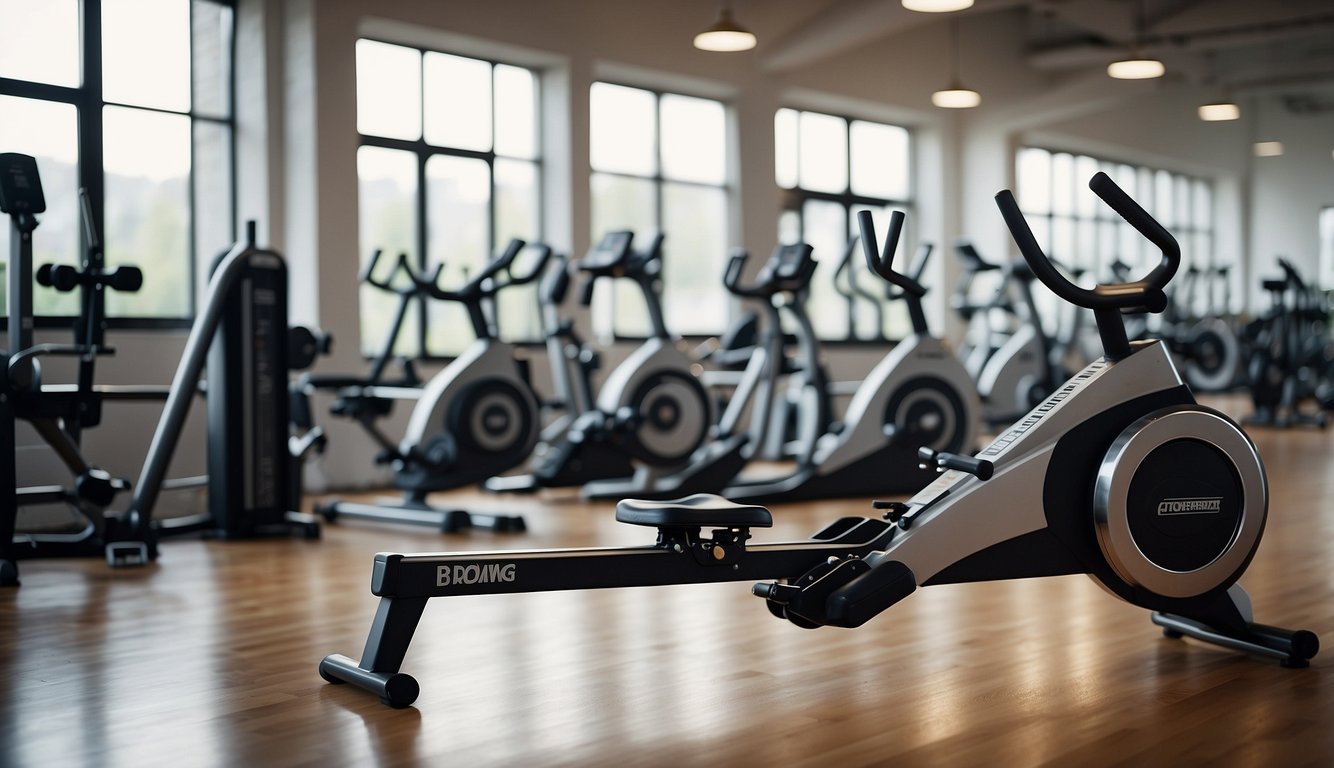Rowing machines offer a comprehensive full-body workout that caters to the fitness needs of a broad range of individuals. Considered a cornerstone in cardiovascular machines, they are highly regarded for their ability to provide an effective aerobic exercise that engages several major muscle groups, including the arms, legs, back, and core, without placing undue stress on the joints.
This low-impact nature of rowing machines makes them a suitable option for individuals at various fitness levels, including those who may need to avoid high-impact activities.

In the context of home gyms, rowing machines present a practical solution for individuals aiming to maximise their exercise routine in the comfort of their own space. They are relatively compact, easy to use, and are available with diverse resistance types—such as air, magnetic, hydraulic, and water—that cater to individual preferences and fitness goals.
Enhanced by technological features that track performance, provide workout variety, and simulate the experience of on-water rowing, these machines support a broad range of workouts from gentle conditioning to intense training sessions.
Key Takeaways
- Rowing machines provide a versatile full-body workout that enhances cardiovascular fitness with minimal joint impact.
- They are well-suited for home gyms, offering multiple resistance types and requiring relatively little space.
- Technological advancements have amplified the effectiveness and user experience of rowing machines.
Benefits of Rowing Machines

Rowing machines offer a comprehensive workout that combines cardiovascular conditioning with strength training, engaging various muscle groups while being gentle on the joints.
Cardiovascular Health
Rowing is an excellent cardio exercise, promoting heart health and increased endurance. By setting a consistent pace, individuals can target their heart rate zone, leading to improved cardiovascular function. Studies suggest that a consistent rowing routine can increase the heart's efficiency, subsequently enhancing one's overall aerobic capacity.
Muscle Engagement
A rowing machine provides a full-body workout involving major muscle groups. The legs, core, arms, back, and glutes are all engaged during the rowing stroke:
- Legs and Glutes: The drive phase starts with the legs, utilising the quadriceps and glutes.
- Core: As the stroke transitions from legs to upper body, the core is activated for stability.
- Arms and Back: The pulling action works the biceps, forearms, and a vast array of back muscles.
Notably, this machine offers a low-impact workout, making it suitable for individuals aiming to minimise stress on their joints.
Types of Resistance

When choosing a rowing machine, the type of resistance mechanism is a fundamental consideration. It affects the feel of the stroke, the sound level, and even the durability of the equipment. Each resistance type provides a distinct rowing experience, from the natural push against water to the precision of magnetic systems.
Water Resistance
Rowing machines with water resistance, such as the WaterRower, utilise a paddled flywheel within a tank of water to simulate outdoor rowing. As the user pulls the handle, paddles spin and push against the water, creating a smooth and natural-feeling stroke. The resistance level is determined by the speed of the rowing motion: the faster one rows, the harder the resistance.
Air Resistance
Air rowers, including the widely acclaimed Concept2 Rowerg, feature a flywheel design that uses air to create resistance. As the user rows, air flows over the flywheel blades, increasing resistance in tandem with the rowing speed. These machines are prized for their durability and the realistic rowing sensation they provide, but they tend to be noisier due to the moving air.
Magnetic Resistance
Magnetic resistance rowers utilise magnets near a metal flywheel to create a silent and smooth rowing experience. They allow for precise control over resistance levels, often through digital settings, making them ideal for those seeking a quiet workout. However, the rowing feel may be less like actual rowing on water compared to air or water resistance rowers.
Hydraulic Resistance
Hydraulic rowing machines often use cylinders filled with oil or air to create resistance. The resistance is typically adjusted by altering the amount of fluid the pistons push through, and they tend to be more compact and budget-friendly. While they can offer a consistent workout, the rowing motion may not be as smooth as with other types.
By understanding the different types of resistance available in rowing machines, users can select the option that best fits their workout preferences and fitness goals.
Features and Technology
When assessing the value of rowing machines, it's important to consider the advanced features and technology they incorporate, such as detailed performance monitoring tools and smart connectivity options that can elevate the quality of the workout.
Performance Monitoring
Rowing machines often come equipped with comprehensive performance monitoring systems. These systems enable users to track a variety of metrics such as stroke rate, calories burned, and time spent on workouts. Devices like the Concept2 Model D Rower feature sophisticated LCD consoles or HD monitors that display analytics for immediate feedback. Such information allows individuals to monitor their progress and tailor their training regimens accordingly.
Smart Connectivity
Smart rowing machines are designed with Bluetooth and Wi-Fi capabilities that facilitate advanced data interaction. Users can have their workout data synced to various fitness apps, allowing for a closer analysis of performance or even virtual competition with other rowers.
The integration with smart devices through a device holder is another key feature, ensuring users remain engaged and can access entertainment or training guides while exercising. These smart features essentially transform rowing machines from standalone fitness equipment into a connected fitness experience.
Comparing Rowing Machines
When assessing the variety of rowing machines on the market, one will consider factors such as brand reputation, build quality, and cost-effectiveness. These aspects are crucial in determining which rowing machine may suit one's fitness needs and budget.
Rowing Machine Brands
When it comes to brands, names like the WaterRower, Concept2 RowErg, and the NordicTrack RW900 stand out. The WaterRower is renowned for its solid construction and utilisation of water resistance to simulate outdoor rowing. Concept2 is a staple in professional rowing circles due to its durability and the robust performance analytics it provides.
Meanwhile, the NordicTrack RW900 appeals to users through integrated technology and interactive programming, often featuring in consumer reports and reviews.
The Peloton Row and Hydrow bring a modern twist to rowing machines with their sleek design and engaging live classes. The Aviron Impact Series and Ergatta offer a gaming aspect to workouts, turning routine exercise into an immersive experience.
These models challenge the notion of traditional home fitness equipment, delivering high-quality workouts with a strong emphasis on interactive elements.
Price and Value
Rowing machines span a broad price spectrum, from budget-friendly options to more premium models. The Concept2 RowErg, characterised as affordable yet durable, represents excellent value for both novice and seasoned rowers, retaining a high resale value.
On the more expensive end, the Hydrow and Peloton Row are positioned as luxury items with their immersive high-definition touchscreen displays and access to live and on-demand classes. Despite the higher price point, customers appreciate the comprehensive package these machines offer, merging durability, advanced features, and interactive content.
In contrast, models like the Aviron Impact Series provide a balance between the high-tech engagement of pricier models and a more approachable price tag. Such machines are often highlighted in reviews for their build quality without breaking the bank, attracting consumers looking for a middle-ground option.
By comparing these factors, consumers can make informed decisions when choosing the rowing machine that best aligns with their personal fitness goals and financial considerations.
Rowing Machine Workouts
Rowing machine workouts are robust training tools that cater to various fitness levels and goals. They can enhance stamina, build strength, and even incorporate an element of gaming for an engaging exercise experience.
Training Programs
Pace: Training programs on rowing machines often focus on the pace, which is typically measured in strokes per minute (SPM). A well-structured program will include low-intensity sessions for endurance, often referred to as 'steady-state' workouts, and high-intensity bouts to build power and speed.
-
Beginners might start with a pace that feels comfortable, gradually increasing SPM as their stamina improves.
-
Advanced rowers may use a variety of paces within a single workout to simulate on-water conditions or to challenge different energy systems.
Fitness Level: Customisable training programs are available, ensuring that individuals of all fitness levels can effectively use rowing machines to meet their personal health and fitness goals.
- Guided Workouts: These programs are often led by experienced instructors who can guide users on proper form and technique, ensuring maximum efficiency and injury prevention, available through on-demand services, apps, or pre-set machine programs.
Workout Variations
Workouts: Rowing machine workouts are diverse and can range from time-based sessions to distance targets. Workout variations ensure users remain engaged and challenged.
- For example, interval training alternates between periods of high intensity and recovery, beneficial for stamina building and cardiovascular health.
CrossFit: Many CrossFit enthusiasts incorporate rowing machines into their routines for a full-body workout that tests both strength and endurance.
- Workouts are often combined with other exercises, such as squats or push-ups, for a comprehensive fitness session.
Games: Some rowing machines offer interactive gaming experiences that can make workouts enjoyable and competitive. These games may simulate racing against others or completing challenges, which can be a motivating factor for many users.
- This playful aspect encourages regular usage, which is critical for sustained fitness improvement.
Build Strength and Stamina: Consistent workouts on rowing machines contribute to not only cardiovascular health but also to overall muscular strength. The compound movements involved in rowing engage multiple muscle groups, offering a comprehensive strength-building session.
Setting Up Your Rowing Machine
Before one begins their journey with a rowing machine, it's crucial to consider the placement of the machine and the ergonomic setup to ensure safety and effectiveness during workouts.
Machine Placement
When placing a rowing machine in a space, be it a home gym or a dedicated gym area, ensure there is ample space around the machine for safety and accessibility. A rowing machine typically requires a rectangular space, and for optimal usage, an area of two metres by one metre is advisable.
If the machine is foldable or has built-in wheels, storing it away after use becomes more convenient, maintaining the tidiness and versatility of the home gym area. One should check for the stability of the machine on the floor; it should not wobble or shift during use.
Ergonomic Considerations
Setting up the rowing machine ergonomically is paramount for preventing injuries and maximising the workout's effectiveness. The seat should be secure and comfortable, and the foot straps adjusted so they hold the feet firmly in place without restricting circulation.
The height of the rail is also an essential factor as it impacts the rowing posture; a rail set too high or too low can lead to an improper technique. The resistance should start at a moderate level, ensuring ease of use for beginners, and can be increased progressively as one's technique and strength improve.
Checking that all adjustable components are accessible and functional is critical for user safety and to ensure a beneficial workout experience.
Maintaining Your Rowing Machine
Proper maintenance of a rowing machine ensures it remains a durable element of fitness equipment, preserving its build quality and functionality over time. Users can continue to confidently rely on their rowing machine for consistent performance by adhering to routine care and addressing common issues.
Regular Care
- Cleaning: After every use, it's essential to wipe down the rowing machine. Sweat and other debris can corrode parts over time.
- Inspection: A monthly check of all parts, including screws, nuts, and bolts, is critical, ensuring everything is tight and secure.
- Lubrication: Key components such as the chain or strap and the seat rail need regular lubrication for smooth operation. The manufacturer’s guide usually specifies the correct type of lubricant.
Troubleshooting Common Issues
- Strange Noises: Should the rowing machine start making unusual noises, one should inspect for loose parts and signs of wear on the flywheel or foot straps.
- Resistance Changes: If the resistance feels off, checking the damper setting for manual machines or examining the magnetic brake on electronic models is advisable.
By prescribing these maintenance tasks, the user can prolong the life of their rowing machine and ensure it remains a reliable piece of fitness equipment.
Frequently Asked Questions
Rowing machines offer a full-body workout and can be an effective part of a fitness regimen. Addressing some common enquiries can help users optimise their rowing experience.
What health benefits can one expect from using a rowing machine regularly?
Regular use of a rowing machine can provide a comprehensive cardiovascular workout, improve muscular strength and endurance, and enhance flexibility. The consistent motion works both the upper and lower body, contributing to improved overall fitness.
How does a rowing machine compare to a treadmill when considering weight loss and cardiovascular health?
When comparing a rowing machine to a treadmill, one might find that rowing offers a low-impact alternative with reduced stress on the joints. Both machines cater to cardiovascular health, but a rowing exercise engages more muscle groups, which could lead to higher calorie burn and increased weight loss potential over time.
What are some common mistakes to avoid for maintaining proper form on a rowing machine?
It is important to avoid rounding the back, jerking the handle, and ignoring the legs' role in the stroke. Proper form involves maintaining a neutral spine, utilising leg power to initiate movement, and ensuring a smooth, controlled stroke to reduce the risk of injury.
Is a short, daily workout on a rowing machine sufficient for overall fitness improvement?
Even a short daily workout on a rowing machine can contribute significantly to fitness improvement, especially when performed with intensity and proper form. Consistent practice can elevate one's heart rate and build endurance.
Can consistent use of a rowing machine lead to a reduction in abdominal fat?
Consistent use of a rowing machine can be part of an effective strategy to reduce body fat, including abdominal fat, due to its high-calorie burn rate and engagement of core muscles.
Are there any negative impacts on health or fitness when using a rowing machine?
Misuse of a rowing machine, such as using incorrect form or overtraining, can lead to muscle strain or injury. It's crucial to start with an appropriate level of resistance and to gradually increase workout intensity to mitigate potential negative impacts.









